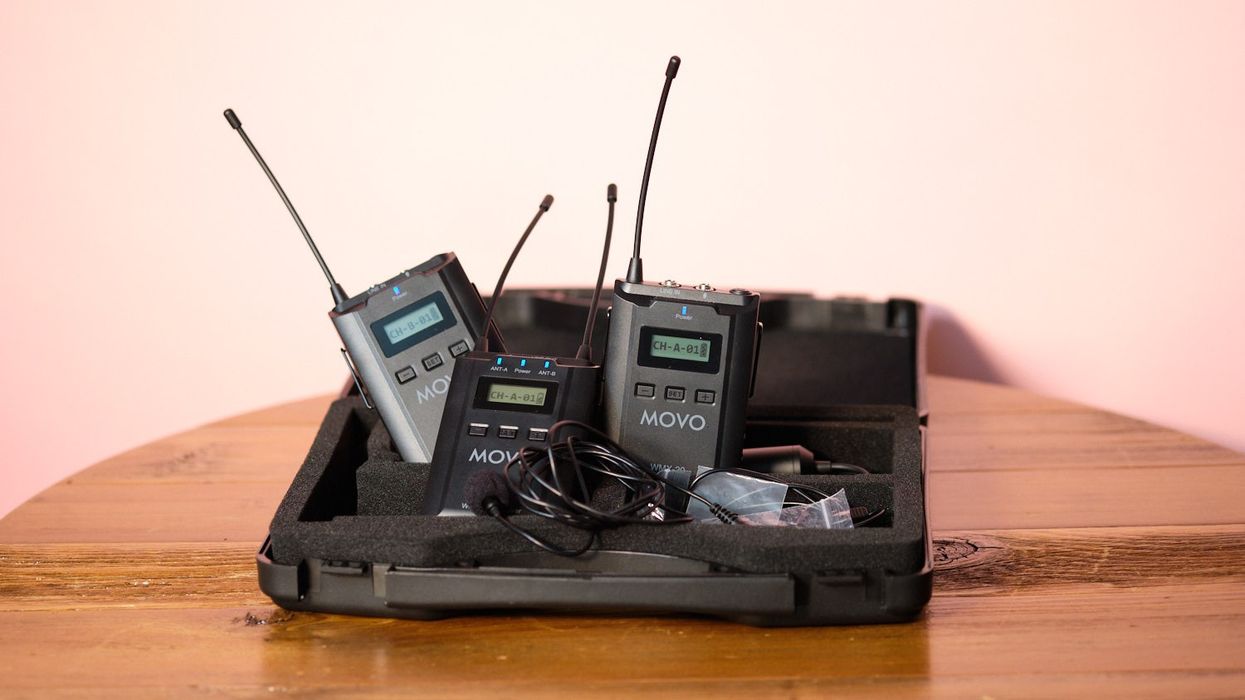Record Two Lavaliers to One Receiver with the Movo WMX20-DUO
Single-operator shoots get way easier with the ability to mike more people from a smaller setup.

In our dream world every shoot we do goes out with a two-person sound team, one running the mixer, one the boom, and every interview subject or performer has a lavalier.
In reality, sometimes we're out in the field just shooting, holding the camera, asking questions, or watching two people talk, and we still want good sound.
This becomes a nightmare if you want multiple lavaliers, since mounting multiple receivers to a small camera ends up taking a lot of room.
The ideal setup has been available for a while now—two lavaliers that go to the same single receiver—but most of the options out there have been justifiably pricey.
Since the shoots where we need this kind of tool (single operator, small camera) are also the shoots also tend to have a very low budget, we have been hunting for a more affordable solution, which is what made the Movo WMX20-DUO unit something we were especially curious to test out.
The WMX20-DUO is a kit that, for under $200, gives you two wireless lavaliers that go back to a single receiver that is compact and designed to easily mount on your cage or the hotshoe of your camera. All the units are very lightweight, and you can easily rig the single receiver to your camera without noticing a major sacrifice in useability.
One particularly nice feature is that the receiver has both a lineout to feed your camera and a headphone out for direct monitoring of the signal coming into the receiver. This is great to monitor for radio dropouts and is also useful when initially setting the system up or working with a smaller camera that doesn't offer both audio input and output.
We used it in three shoots over the last two months and found ourselves very satisfied with the results. Lavalier recording is never going to sound as good as boom mic in most situations, but sometimes it's your best bet to get solid audio, and we were able to use the sound recorded with these very reliably in the edit.
One feature we particularly loved was that it still runs on AA batteries. While we like that many systems are moving to USB charging and internal batteries, that requires nightly charging and being ready to plug in external power if they run down. We just kept a bunch of fresh Eneloop rechargeables on standby for these and got through our days.
The main drawbacks of the system are from its sheer simplicity. You don't get the wide variety of channel selection you might get from a competitor, so they aren't going to be as ideal if you are working in a very busy RF situation (like shooting a trade show).
The build quality is very lightweight; this has benefits (you aren't carrying extra weight), but also drawbacks in terms of worries about durability. If I booked a six-week job in the jungle doing chaotic work, I would definitely bring along a spare set, but they should survive relatively normal production well.
You can't live mix, so if one of your performers starts talking more quietly halfway through a scene, you can't bump it up. And compared with solutions from companies like Deity, it doesn't offer a lot of nice features like timecode support.
Despite those drawbacks, however, it is a surprisingly useful device for its incredible price point. It really comes down to what do you need them for. If you are doing a big multi-camera shoot where the timecode features are worth it, the limitations here might be frustrating. But if you are tired of doing a lot of shoots where you decide which one person gets the lavalier while you hand hold another microphone hard-wired into the system, these are absolutely worth a look.
Check out their site for more info.















